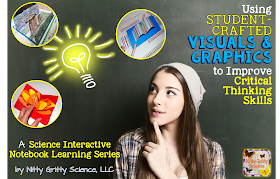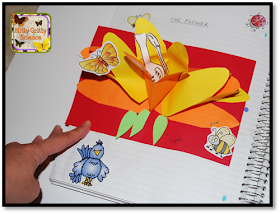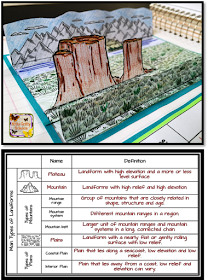
Studies have revealed that when teachers are selecting instructional materials for their classrooms, visuals and graphics need to be considered, particularly with technical courses such as science (Wright et al. 2014). Using eye-catching visuals to reinforce student learning help students comprehend abstract scientific theories and help them improve their critical thinking skill.
By using Science Interactive Notebooks in your classroom, you are taking visual and graphic learning for your students to an entirely new level. Students aren't just seeing stunning images and useful graphics in a textbook or PowerPoint presentation, they are actually CREATING them to use as their own science resource!
By allowing students to create engaging graphics and manipulate paper models, you are integrating practices of science and engineering that the NRC Framework identifies as essential for all students to learn (NRC Framework, 2012, p. 30).
Now, I don't think it's a big secret that I'm a HUGE fan of Science Interactive Notebooks for many reasons, but today my focus is in the benefits of images and visuals that many of my student output activities feature, such as sequencing, paper models and English Language Learner (ELL) support.
SEQUENCING:
Sequencing is a skill that contributes to a science student's ability to comprehend what they have learned and apply it. By doing this, they will be able to show that they understand that events occur in an order and need variables in place for each step to occur. An example of this is from my Life Science Interactive Notebook where students compare the sequence of events between primary and secondary succession.

Using models in the science classroom serve many applications, such as exploring "what if" scenarios, or having them manipulate them to observe the models behavior in relationship to different inputs.

In the case of using paper models in Science Interactive Notebooks, I use paper models to introduce important terms as well as provide an opportunity to explore the process they are learning, such as building the 3-D Flower or manipulating the "ocean floor" to observe Sea Floor Spreading.
ELL SUPPORT:
The Next Generation Science Standards (NGSS Lead States, 2013) suggest that science teachers can provide language support strategies for their English Language Learners (ELLs) with multiple modes of representation besides text, such as pictorial and graphic. A perfect example of this is when students make the connection in the Main Types of Landform activity where they create a model of the landforms, then can connect those pictures to the vocabulary term and definition with the supporting data table, as shown:
Student-created graphics and visuals have great potential to support science content knowledge development. Teachers need to provide opportunities for students to apply what they have learned, and with limited resources, a Science Interactive Notebook is a perfect solution for students to show their level of comprehension in a visually stimulating manner.
I invite you to share pictures of YOUR students' interactive notebooks and I will happily feature them here on my blog. For your time, you will receive a FREE set of task cards - just email pictures to: nittygrittyscience@gmail.com.

NGSS Lead States. 2013. Next Generation Science Standards: For states, by states (Appendix D, Case study 4: English language learners and the Next Generation Science Standards). Washington, DC: National Academies Press.
Wright, K.L., E.M. McTigue, Z. Eslami, and D. Reynolds. 2014. More than just eye catching: Evaluating graphic quality in ELL science textbooks. Journal of Curriculum and Instruction 8 (2): 89–109


I very much enjoyed this post. You nailed it!
ReplyDeleteThanks so much Amy! I've had this post rambling around in my head for awhile now and finally got it out :)
DeleteYour resources are amazing! I can't wait to use some in my classroom!
ReplyDelete